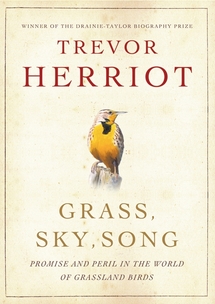Reviewed by Grant McCreary on August 4th, 2009.
Grasslands are one of North America’s most endangered habitats. As a result, grassland birds, as a whole, are declining faster than any other group of birds. Trevor Herriot has experienced this firsthand, living on the Saskatchewan prairie. He has noticed birds that used to be common, such as Burrowing Owls and Chestnut-collared Longspurs, have now all but disappeared.
Grass, Sky, Song chronicles his attempt to find out why, and what might be done to stop it.
The book starts out strong with one of the best introductions that I’ve read. It nicely introduces the reader to the landscape, but more so to the author himself, and what he is trying to accomplish here.
From there, the author continues to acclimatize his readers with the Canadian Great Plains. We meet the birds – Sprague’s Pipit, McCown’s Longspurs, and Horned Larks. We see the land – the grass, hills, and wooded riparian areas. It sounds lovely.
But there are problems. Instead of simply listing and discussing each issue, Herriot takes the reader out and shows them. We join the author as he walks around his well-managed property. We see and hear the special birds that still live there. Still, things have changed from the way it was pre-settlement. There are more trees, and invasive plants are pushing out the native species. This means there is less room for birds that need open, native grass.
Looking further afield there are more serious issues. Almost everywhere you look, the land has been overgrazed, or even worse, plowed up and planted with monoculture crops. Pesticides have been liberally applied just about everywhere, most definitely affecting the birds, but possibly also the ones who are spraying it.
Herriot describes how all of these changes have affected the birds. Some species are adaptable and can cope with some of these changes. For instance, if field margins are left unsown and allowed to go to weed, Western Meadowlarks and some others can still hang on and breed successfully. But if everything is soaked in pesticides, they can’t find enough food to feed nestlings. And even worse, more and more operations are eliminating these weedy margins in order to maximize their crop. Thus, unsurprisingly, the population trends for most prairie birds are trending in the wrong direction.
These problems seem even more daunting when contrasted against how the area appeared before settlement. To get an idea of what that was like, the author turns to John Macoun, a naturalist-explorer who, in the late 1800’s, first explored the region. His journal tells of how the land looked and the multitude of birds he encountered. Herriot takes us along as he retraces Macoun’s steps and compares his descriptions to the current conditions. Although very little of the native prairie that Macoun found survives today, I found this journey extremely fascinating and enlightening.
Herriot paints a very dire portrait of the current state of the continent’s grasslands and the creatures that inhabit it. He had set out to look for someone or something to blame. But he found that it wasn’t that simple. There is no single scapegoat, no one place to heap all the culpability. It’s not just the government, or even the farmers. In fact, we all have a share in the responsibility.
But there is still hope. As you would expect, we are given some things that each of us can do. But I was also encouraged by the individuals the author introduces us to along the way, those who truly care about the land, along with its birds and other creatures.
Recommendation
Grass, Sky, Song is an extremely well-written look at the state of North American grasslands and its birds. Although it focuses specifically on the Canadian Great Plains, it is applicable across the continent (and probably the world). As the author discovers, what is happening to the birds in his area, at the northern limits of the prairies, will soon be happening further south. We all need to take heed.
Herriot may not have found exactly what he set out for, but the book definitely serves a purpose. It will give you an appreciation for this imperiled ecosystem, alert you to the dangers it faces, and encourage you to do something about it. I would highly recommend this book to anyone interested in grasslands and its birds, or conservation in general.
Trevor’s blog has some great information and expounds upon the concepts from his book.
Disclosure: I get a small commission for purchases made through links in this post.
Disclosure: The item reviewed here was a complementary review copy provided by the author. But the opinion expressed here is my own, it has not been influenced in any way.





Comment